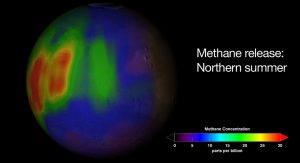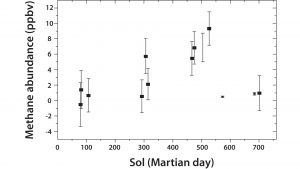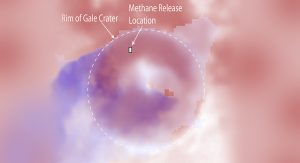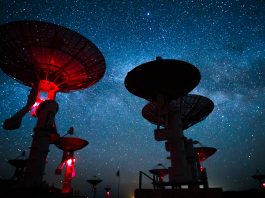Dr Scot Rafkin, Programme Director at Southwest Research Institute, describes the puzzling, putative observations of methane on Mars and the importance of that gas to the search for present day life on the Red Planet.
The exploration of Mars has been driven strongly by questions about life. Does Mars have life, or has it supported life in the past? The simple molecule methane (CH4) has an important role in answering that question, but as putative detections of methane gas in the atmosphere of Mars have rolled in over the last two decades, the results have raised far more questions and done little, so far, to actually answer the question about the presence of Martian life.
Methane is of interest because it is known to be a common byproduct of microbial metabolism on Earth; that is, the presence of methane can be a signature of life. On Earth, greater than 80% of methane in the atmosphere is of biological origin. At the same time, the solar system is full of methane of abiological origin. Methane was abundant in the solar nebula from which our solar system formed, and methane can be generated from geophysical processes.
When it comes to the triumvirate of Mars, methane, and life, it is not so important as to whether there is methane, but rather how much there is and how variable it is in space and time. Furthermore, if it can be determined, the abundance of isotope 14C is important because it is a key marker of biological processes.

Detection of methane
The first reported detection of methane in the atmosphere of Mars was through spectroscopic observations taken during the Mariner 7 flyby of Mars in 1969. Initially, the detection was heralded as a major discovery, followed by increased scepticism. Shortly thereafter scientific consensus overturned the result when the detection was shown to be due to the presence of carbon dioxide ice rather than methane in the atmosphere.
The priorities of the USA and NASA shifted away from Mars after the Viking missions in the late 1970s, and many important questions about Mars, including those surrounding life, were left unaddressed for almost two decades. That changed in 1996 with the launch of the Mars Pathfinder mission, which heralded a new era of robust Mars exploration that continues to this day.
During the intervening decades between Viking and Pathfinder, the telescopes on Earth advanced considerably. These advances made it possible to obtain increasingly precise measurements of trace gas abundances on Mars from Earth-based observations. And, following the Pathfinder mission, orbiting spacecraft from both the US (NASA) and Europe (ESA) arrived at Mars with instruments that could make limited atmospheric composition measurements.
The first two modern era detections of Mars methane were published at nearly the same time in 2004. Both came in with a consistent global average value of 10 parts per billion (ppb). One of the detections, however, also indicated spatial variability ranging from 0 ppb to as much as 60 ppb. Over the next 10 years, numerous other detections from both telescopes and Mars orbiters found a similar range of values.
A series of telescopic detections reported in 2009, but made between 2003 and 2006, had a particularly large impact in the scientific community. Over 30 ppb of methane was found to come and go over large regions of Mars as a function of season and year. These results were reasonably consistent with the prior measurements, but the fidelity of the geographic mapping of the methane was spectacular. These large plumes of methane were difficult to reconcile with the understanding of Mars’s atmospheric circulation and chemistry.

The Mars methane mystery
The atmosphere of Mars has circulation patterns that are not unlike Earth. As on Earth, any particulate or gas that is released into the atmosphere will generally be transported and mixed away from the source location. A large plume of methane similar to that reported in 2009 should be mixed and transported to a near uniform global value of two or three ppb in a matter of weeks to perhaps a month or two.
Methane is thought to have a lifetime of greater than 100 years in the atmosphere of Mars. Methane can be destroyed through naturally occurring chemical reactions and by ultraviolet sunlight breaking apart the molecule. If large plumes of methane were being periodically released, as observed, then the global average abundance should continue to increase, because very little of the methane could be destroyed in such a short period of time. This is the mystery of Martian methane. How could methane behave as observed and simultaneously fit with the known atmospheric circulation and chemistry?
The mystery is deepened further in that even if it were possible to come up with a mechanism by which methane could be destroyed at a much greater rate, the destruction mechanism would have to be highly selective for methane and not disrupt other known chemistry. For example, if accelerated oxidation of methane were invoked, that would solve the methane destruction problem, but it would also result in oxygen abundance that is far below what is observed and would result in an increase in other chemical byproducts that are equally not observed.
One possible answer to the mystery is that the methane measurements are in error. Are all the putative detections a repeat of the Mariner 7 scenario? As the science community struggled to resolve the methane mystery, scepticism about the measurements began to increase, culminating in a paper in 2011 that provided strong arguments indicating that prior measurements were substantially in error. One by one, each of the detections was shown to have potential problems: confusion of the Martian methane with the signal of methane on Earth; inadequate instrument resolution; poor instrument stability; or data analysis issues. The result was a community deeply split into those who accepted the evidence of detection, even with the potential faults, and those that rejected the high abundances and variability.
The Mars Science Laboratory Rover Curiosity was supposed to be the arbiter of the disagreement. The rover carried the first instrument to the surface specifically designed to measure methane. If methane was there in the previously observed abundances, the rover would measure it, and it would measure variability if there was variability.
In 2013, the first measurements came in. Methane abundance was determined to be no more than 1.3 ppb. This was substantially lower than previous measurements. Taking into account the mixing of the atmosphere, this gave immediate and credible weight to the sceptical camp. By 2015, the rover had made multiple measurements at different seasons. The overall average background measurement fell even further to 0.69 ppb. But, strikingly, there were a few measurements that spiked to greater than seven pbb. Similar background values with sporadic peaks have been observed up to the present. Some argued that this validated the prior measurements, but these peaks are still far below the large and widespread values occasionally observed through other methods. Others still argued that the rover measurements were in error.
One possible solution was that the releases measured by the rover were correct but represented highly concentrated and very localised releases very near the rover. This was a hypothesis that my research group investigated through the modelling of the Martian atmosphere. We found that while nearby local releases could produce variability in methane concentration, it was not possible to reproduce the rover observations without scenarios that would not also raise the global methane value. Further, it would require that the rover was so lucky as to set down in one of the few places on all of Mars that were emitting methane. If the rover measurements were accurate, it did little to resolve the methane mystery: the results were still incompatible with the atmospheric circulation and chemistry.

The mystery remains
The Mars Trace Gas Orbiter (TGO) led by the European Space Agency arrived at Mars in 2016 and began science observations in 2017. This spacecraft was designed to make exquisitely sensitive measurements of methane and other gases around the planet. The US was supposed to be a major contributor to TGO but pulled out of the programme in the early stages of development. The vacuum was filled by Russia, which provided an instrument suite complementary to the existing European payload, both of which could make independent and corroborating methane measurements.
The TGO results were greatly anticipated, and in 2019 the initial measurements were revealed: Nothing! No methane was found down to the detectability limits of the instruments, which was far below the one ppb observed by Curiosity. Still, there was controversy. The measurements were taken during one of Mars’s infamous global dust storms, which made it impossible for the orbiter to measure the atmosphere all the way down to the surface. Perhaps the methane was hiding close to the surface, or perhaps the dust storm altered the chemistry. Subsequent observations long after the dust storm subsided have still come back with no more than 50 parts per trillion of methane.
Despite multiple attempts over many decades to accurately measure methane, and if there, determine whether it is of biological origin, the mystery remains. Is there methane? How much? How variable is it? How can methane abundance and variation be explained in the context of the atmospheric circulation and chemistry? These questions may not be solved for quite some time. There are no further plans to send additional spacecraft to Mars that might help solve the mystery with new measurements. But everybody loves a good mystery. It will be solved one day.
References
- Herr, K.C. and Pimentel, G.C., 1969.’ Infrared absorptions near three microns recorded over the polar cap of Mars’. Science, 166(3904), pp.496-499
- Zahnle, K., Freedman, R.S. and Catling, D.C., 2011. ‘Is there methane on Mars?’. Icarus, 212(2), pp.493-503
- Mumma, M.J., et al., 2009. ‘Strong release of methane on Mars in northern summer 2003’. Science, 323(5917), pp.1041-1045
- Korablev, O., et al., 2019. ‘No detection of methane on Mars from early ExoMars Trace Gas Orbiter observations’. Nature, 568(7753), pp.517-520
- Webster, C.R., et al., J., 2015. ‘Mars methane detection and variability at Gale crater’. Science, 347(6220), pp.415-417
- Pla‐Garcia, J., Rafkin, S.C., Karatekin, Ö. and Gloesener, E., 2019. ‘Comparing MSL Curiosity rover TLS‐SAM methane measurements with Mars Regional Atmospheric Modeling System atmospheric transport experiments’. Journal of Geophysical Research: Planets, 124(8), pp.2141-2167
Dr Scot Rafkin
Programme Director
Southwest Research Institute
+720 240 0116
rafkin@boulder.swri.edu
http://boulder.swri.edu
http://swri.org
Please note, this article will also appear in the third edition of our new quarterly publication.









